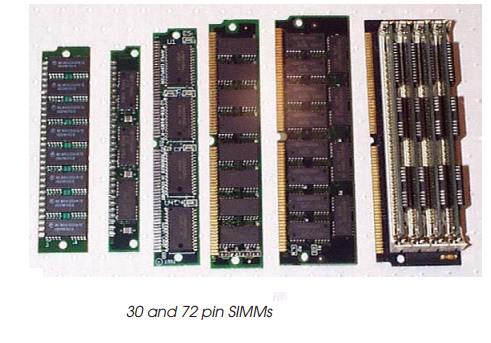Chapter: Embedded Systems Design : Memory systems
Packages
Packages
The major option with memories is packaging. Some come encapsulated in
plastic, some in a ceramic shell and so on. There are many different types of
package options available and, obvi-ously, the package must match the sockets
on the board. Of the many different types, four are commonly used: the dual in
line package, zig–zag package, SIMM and SIP. The most common package
encountered with the MAC is the SIMM, although all the others are used,
especially with third party products.
Dual in line package
This package style, as its name implies, consists of two lines of legs
either side of a plastic or ceramic body. It is the most commonly used package
for the BIOS EPROMs, DRAM and SRAM. It is available in a variety of sizes with
24, 26 and 28 pin packages used for EPROMs and SRAMs and 18 and 20 pin packages
for 1 Mbit × 1 and 256 kbit × 4 DRAMs. However, it has
virtually been replaced by the use of SIMM modules and is now only used for
DRAM on the original MAC 128K and 512K models and for DRAM and for EPROM on
models up to the MAC IIx.
Zig–zag package
This is a plastic package used primarily for DRAM. Instead of coming out
of the sides of the package, the leads protrude from the pattern and are
arranged in a zig-zag — hence the name. This type of package can be more
difficult to obtain, compared with the dual in line devices, and can therefore
be a little more expensive. This format is often used on third party boards.
SIMM and DIMM
SIMM is not strictly a package but a subassembly. It is a small board
with finger connection on the bottom and sufficient memory chips on board to
make up the required configuration, such as 256 Kbit × 8 or × 9, 1 Mbit × 8 or × 9, 4 Mbit, and so on. SIMMs have rapidly gained favour and many new
designs use these boards instead of individual memory chips. They require
special sockets, which can be a little fragile and need to be handled
correctly. There are currently two types used for PCs: the older 30 pin SIMM
which uses an 8 or 9 bit (8 bits plus a parity bit) data bus and a more recent
72 pin SIMM which has a 32 or 36 bit wide data bus. The 36 bit version is 32
bits data plus four parity bits. Apple has used both types and a third which
has 64 pins but like the IBM PC world standardised on the 72 pin variety which
suited the 32 bit processors at the time. With the advent of wider bus CPUs,
yet another variation appeared called the DIMM. This typically has 168 bits but
looks like a larger version of the SIMM. With the wider buses came an increase
in memory speeds and a change in the supply voltages. One method of getting
faster speeds and reduced power consumption is to reduce the supply voltage.
Instead of the signal levels going from 0 to 5 volts, today's CPUs and
correspond-ing memories use a 3.3 volt supply (or even lower). As a result,
DIMMs are now described by the speed, memory type and voltage supply e.g. 3.3
volt 133 MHz SDRAM DIMM.

The older 30 pin SIMMs are normally used in pairs for a 16 bit processor
bus (80386SX, MC68000) and in fours for 32 bit buses (80386DX, 80486, MC68030,
MC68040) while the 72 pin SIMMs are normally added singly although some higher
performance boards need a pair of 72 pin SIMMs to support bank switching.
SIP
This is the same idea as SIMM, except that the finger connections are
replaced by a single row of pins. SIP has been overtaken by SIMM in terms of
popularity and is now rarely seen.
Related Topics